Just in case you thought we at CKHH have been doing nothing for the last three weeks and that we are intending to do nothing for the next similar period, I thought I would give you, our loyal readership, a brief update before we actually do the events lined up for August.
Now these July events are in no particular order, although I will begin with Dr Claire Bartram’s new senior appointment within the Faculty, specifically within the School of Humanities and Educational Studies. From September, Claire will be the Section Lead for Humanities, thereby becoming Dr Stefania Ciocia, the Head of this School’s deputy for this part of the School. Congratulations, Claire, we are delighted and are sure that you will fill this post admirably in what remain challenging times within this sector of higher education.
Over the last couple of months, Claire has been busy enhancing the Centre’s media profile, for in addition to twitter she has been busy using Instagram and is building up a goodly following – great to see!
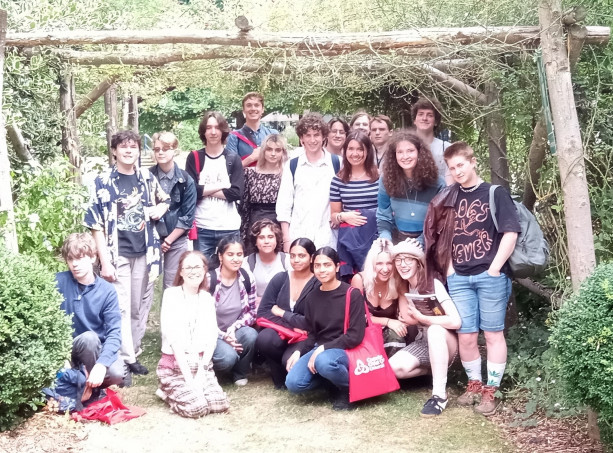
I will get on to Dr Diane Heath’s busy July in a minute but keeping with the idea of making links through social media, it was brilliant to be able to welcome Cherwell School from Oxfordshire to Canterbury last week. Charlotte Richer and her colleagues brought 25 of her Year 12 students to the university, and because of the logistics of the day, the first thing on their itinerary was a tour of the university’s beautiful campus – even during what is really a drought – led by two excellent CCCU student ambassadors. They did a great job of showing the sixth formers around before lunch and then the students enjoyed a workshop on Chaucer’s Canterbury and late medieval pilgrimage.
As a way to introduce these students to the value of exploring the context of literary texts – Chaucer’s Canterbury Tales, the thrill of using primary sources and the need to look at a range of sources that ‘speak to each other’ to provide a more holistic understanding, the group divided into five sub-groups, each with their own source. Thus people looked at wills and material culture, specifically pilgrim badges; the workings of St Thomas the Martyr’s pilgrim hospital in Canterbury High Street – still there today but no longer involved in the maintenance of the city’s Eastbridge; what we can glean from the civic records about the city’s annual St Thomas Pageant; how the early 15th-century customary of St Thomas can illuminate the relationship between monastic cathedral and pilgrimage centre, and finally what the composer of the Prologue of the Tale of Beryn hoped his audience would emulate if/when they, too, came on pilgrimage to Canterbury in May.
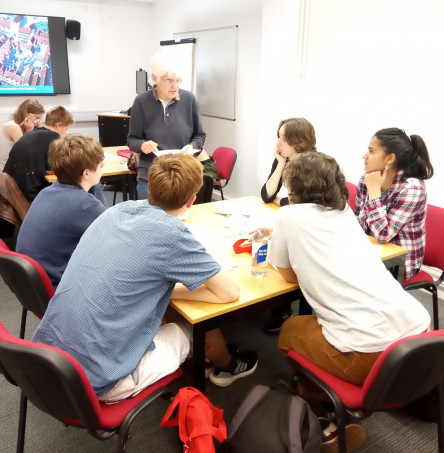
These sources in the students’ hands generated considerable discussions within their groups and then together and there were some great ideas coming from the different groups. Hopefully, this all informed the next part of their visit which was to the cathedral and archives, and I think it may have done because a few days later Charlotte sent some photos and reported that “it [the workshop] had framed the trip for the students superbly.” The following day they were walking from Chilham to Canterbury, emulating Chaucer’s ‘pilgrims’, as well as those of the Prologue writer, by telling stories along the way, and as Charlotte said, “Our pilgrimage … was suitably full of just enough adventure to be memorable!” Charlotte hopes to bring another such group next summer.
Just very quickly, over the last few weeks I have had various meetings concerning the early stages of hopefully what will be a major project at St Dunstan’s church involving education, mission and heritage of this iconic church on the London Road. Secondly, things are picking up momentum regarding the Lossenham Priory Study Day and, in addition to a wills group meeting, I have been busy doing a bit of editing and image hunting for what look like some fascinating exhibition topics created by various wills group members. Thirdly, I had a meeting at Faversham, and although even more early stages, this continues to be a good avenue for the CKHH to be involved in, not least because Faversham was a fascinating place in medieval and early modern Kent maritime community [communities] terms – yes that project is still happening too! Moreover, you cannot have a summer without a busman’s holiday, and this year this took me to Almondbury in Yorkshire during the two hottest days on record. Fortunately, the church was relatively cool – the advantages of lofty stone buildings, albeit photographing the high ceiling bosses in sufficient detail without a telephoto lens or tripod can be described in one word – challenging. However, hopefully I have enough for a lecture there in October on its early Tudor religious and cultural implications!!
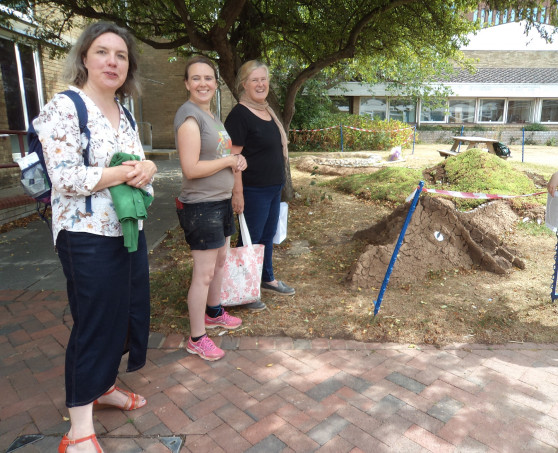
As you would expect, Diane has been very busy too, and she is developing a knack for getting both internal and external funding, to complement her ‘Medieval Animals Heritage’ project and her Sustainability and Green Heritage initiatives. The Becket Garden dragon has been very much to the forefront of all of this and has continued to attract undergraduate, postgraduate, staff and members of the public as helpers and viewers. It is now to all intents and purposes finished, although watering the sedum and moss will be an ongoing job unless the weather takes a dynamic shift (as it did in 1976). Consequently, very special thanks must go to Dr Pip Gregory, who has taken over as project manager for the dragon’s construction, and who has worked tirelessly in some very hot conditions and whose design flair is amazing. Also many thanks to John Hills, from Sustainability and Geography, who has been a stalwart throughout the project in so many ways, and to Matt from the gardening team. Our student helpers have included too many to mention, but Max and his scout troop and Eli, who was still helping on the final day, exemplify the great spirit among the students to get stuck in, sometimes literally with the degree of mud applied. Laine, too, although not from CCCU, has given valuable assistance throughout and is another person who has been prepared to get pretty muddy in the dragon’s cause.

In addition to her dragon-building activities, Diane was instrumental in a workshop on amulets. This is her summary of the day: “The Amulets workshop was held on Monday 25 July at the Science Museum. In addition to medievalists and curators, we also invited an archaeologist, a medical anthropologist, a psychiatrist, and a professor of religion and history. We all met up to think about how amulets, core to so many belief systems over many centuries, might bridge the gap between traditional and folklore paths to healing and modern medicine.
After a terrific tour of the Faith, Hope and Fear gallery in the Science Museum, led by Sarah Bond, where we investigated over a hundred objects arranged in groups: luck, war, child, animals, protection, illness and death, we returned to the discussion room where we considered how these groupings helped our understanding of how amulets work. Those researching medieval attitudes to pregnancy and childbirth spoke of people now needing comfort of the sort provided then by communal caring, birth girdles, hagstones and birth amulets, especially when faced with loss by miscarriage or stillbirth. Others explored the evil eye, and whether such charms were touristic or purposeful. Dan Levene spoke of magic bowls with magic formulae that were buried to send messages to demons. Others thought of how death now can be lonely and clinical in contrast to the busy medieval deathbed full of family, debtors, friends and neighbours where a painful end was welcomed as it meant lesser punishment in purgatory.

Making amulets as a healing action was also noted as a possibility and the beautiful study in bronze by Eleanor Crook was frequently brought up as a fascinating example of art and science in tandem. After such a fascinating day, the next stage is an ‘amuletter’ and a more formal conference as we hone ideas, perhaps set up research focus groups in a bid to help people reconnect in ways that have been helpful in some ways in the past.”
Also this week the Kent History Postgraduates group held its final meeting for this academic year and we again used a hybrid system with seven including Alison Norton, the presenter, in the room and four people online. For her doctorate, Ali is undertaking a topographic analysis of castles and churches in Norman England, under Dr Leonie Hick’s supervision, taking as her regional case studies predominantly rural sites in Devon and Dorset. She is making considerable use of GIS and LiDAR with the intention to build a model of how to investigate such sites to see if castles and churches during this period were located to be interactive visually and spatially. This is an exciting project, and Ali took us through a couple of her specific paired sites to demonstrate the relative importance of rivers and roads for these castles and churches. Her presentation provoked considerable discussion with questions and comments addressed to Ali from those in the room and from those online. She will be giving a similar presentation at a conference soon and hopefully the feedback was helpful in that regard. So thanks very much Ali for sharing the results of your research thus far and great to underline the value of the regional approach to such topics. We finished the session by discussing how we might go forward as a group for the next academic year, including hopefully welcoming new members who are about to start their doctoral projects.
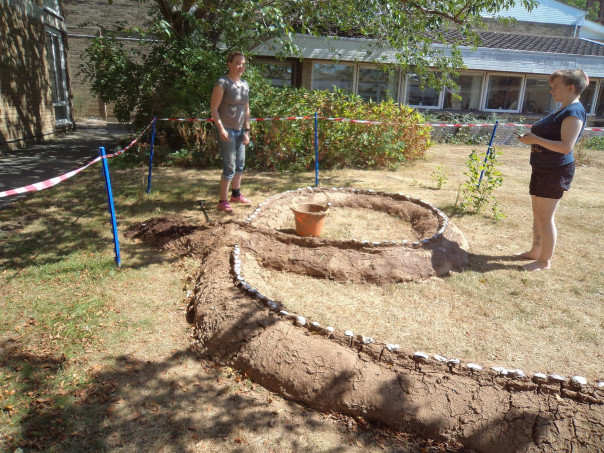
That’s what we have been doing and now for what we will be doing. I’ll start with Diane, and she with Pip’s help will be keeping a watchful eye on the ‘Francis the dragon’ building project that will be taking place at the Franciscan Gardens over the next couple of weeks. The dragon is coming as the equivalent of a flat pack to be assembled at the Gardens by a team, led Dr Ambrose Gillick of the University of Kent’s School of Architecture, and the winning team of students. The idea being that it will be ready for visiting by SEND children and their families who will be coming to Canterbury towards the end of August to attend a performance at the Marlowe Theatre.
Talking of plays and acting, Diane’s next event is ‘The Becket Play’ by Penny Bernard, which is a 5-day series of workshops and events for SEND children in and around Sandwich, held in a beautiful Romanesque Church. As Diane says, “this is loosely based on Canterbury’s early Tudor Becket pageant (article in KAS’s Archaeologia Cantiana: https://www.kentarchaeology.org.uk/arch-cant/vol/137/looking-past-st-thomas-pageant-early-tudor-canterbury ) and for these workshops, we ie Diane, Pip and Martin Crowther will be drawing on our Medieval Animals Heritage work to ask children to be dragon-like kings, chough monks, busy bee citizens and wolf-like knights with Becket as a lamb. The play should be huge fun, and we are very much looking forward to creating something very special, that celebrates a fantastic medieval story on our own doorsteps.
Here’s a fragment from the altarpiece now held in the V&A of Becket arriving in Sandwich after his exile in France. We have, thanks to Dr Catriona Cooper, taken 3D scans and with the kind help and support of Laura Chase at the V&A (and Steve Dey at ThinkSee3D) will produce a small 3D model – so children can hold this piece of medieval history in their hands.
https://collections.vam.ac.uk/item/O70796/st-thomas-becket-landing-at-relief-unknown/ So this promises to be a truly exciting week!”
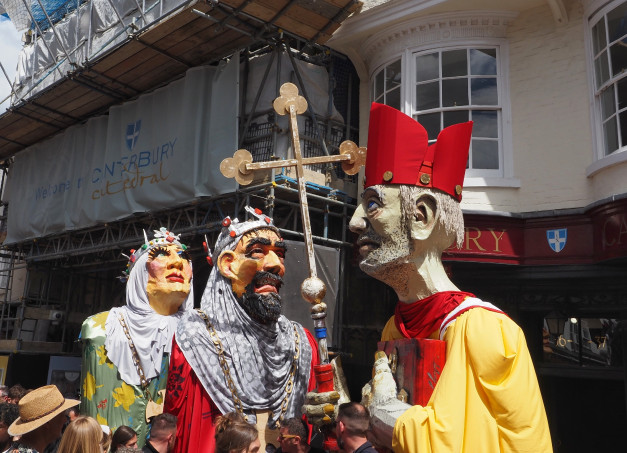
Turning to others, Dr Martin Watts will be heavily involved at the Whitstable Harbour Days (13th and 14th August), for more details see: https://www.whitstablecoastaltrail.org.uk/harbour-day and Facebook for ‘Whitstable Harbour Day’: https://www.facebook.com/whitstablemaritime/ and CCCU will be issuing a press release in the leadup to the weekend.
Also coming up soon is the next monthly meeting of the Lossenham Project wills group, and this time we will be at Lossenham. This will be helpful because it will give those who haven’t seen the early September Study Day venue an opportunity to do so, as well as providing the chance to discuss final preparations for the day and the continuing work on transcriptions and additions to the group’s data base. Moreover, it will also provide an opportunity to make a call for further volunteers because a new series of palaeography online workshops for beginners will take place in the early autumn, once I know what I’m doing then. If the Lossenham Project looks of interest, please check out the website with its monthly newsletters: https://lossenham.org.uk/
Otherwise from my perspective, August is more a matter of writing, researching and writing in that order. That is finishing off pieces on medieval Dover, and specifically St James’ parish; and doing two thematic related pieces, one an article, the other a long conference paper on late medieval immigration to Canterbury and Kent’s port towns respectively. I also need two short papers for September, one on medieval pilgrimage and Dover for the Kent Pilgrim Festival, specifically the symposium at CCCU on 21 September. The second is for the joint CKHH and KAS conference on ‘Resistance and Revolt in Kent from the Conquest to the Present’ on Saturday 24 September, also at CCCU. We have the programme and booking for this FREE conference available very soon. We have a great line up of Professors Carl Griffin and David Killingray, and Drs Andrew Richardson, Lorraine Flisher, Dean Irwin and Stuart Palmer. Thus, as you can see things don’t really stop and of course there will be even more from the beginning of October, including an ‘in conversation’ event as part of the Black History month, talks linked to Canterbury Festival, more joint conferences and lectures, and then for the last weekend next April, Tudors and Stuarts History Weekend 2023 – another busy year ahead!!
 Centre for Kent History and Heritage
Centre for Kent History and Heritage Sheila Sweetinburgh
Sheila Sweetinburgh 1451
1451

